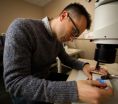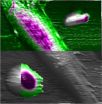(Press-News.org) In 1991, a team led by Washington University in St. Louis paleoanthropologist Glenn Conroy, PhD, discovered the fossils of the first — and still the only — known pre-human ape ever found south of the equator in Africa after only 30 minutes of searching a limestone cave in Namibia.
Traditionally, fossil-hunters often could only make educated guesses as to where fossils lie. The rest lay with chance — finding the proverbial needle in a haystack.
"I don't want to say it's total luck," says Conroy, professor of physical anthropology in Arts & Sciences, "but it's a combination of hard work, meticulous planning and, well, a good dose of luck."
But thanks to a software model used by Conroy and researchers at Western Michigan University, fossil-hunters' reliance on luck when finding fossils may be diminishing.
Using artificial neural networks (ANNs) — computer networks that imitate the workings of the human brain — Conroy and colleagues Robert Anemone, PhD, and Charles Emerson, PhD, developed a computer model that can pinpoint productive fossil sites in the Great Divide Basin, a 4,000-square-mile stretch of rocky desert in Wyoming.
The basin has proved to be a productive area for fossil hunters, yielding 50 million- to 70 million-year-old early mammal fossils.
The software builds on satellite imagery and maps fossil-hunters have used for years to locate the best fossil sites. It just takes the process a step further, Conroy says.
With information gathered from maps and satellite imagery — such as elevation, slope, terrain and many other landscape features — the ANN was "trained" to use details of existing fossiliferous areas to accurately predict the locations of other fossil sites elsewhere in the Great Divide Basin.
Because few sites are 100 percent identical, researchers had to "teach" the ANNs to recognize sites that shared key features in common. With the help of guidance from the scientists, the ANNs use pattern recognition to identify sites that share similar features.
"The beauty and power of neural networks lie in the fact that they are capable of learning," says Conroy, also a professor of anatomy and neurobiology at the School of Medicine. "You just need to give them a rule to deal with things they don't know."
Conroy and colleagues tested the software at the Great Divide Basin last summer. The ANNs correctly identified 79 percent of the area's known fossil sites, and 99 percent of the sites it tagged contained fossils.
Next up, the scientists tested the software on the nearby Bison Basin, also in Wyoming. Despite having been taught to recognize fossil sites at a neighboring location (the Great Divide Basin), the ANNs correctly identified four fossil sites in the Bison Basin.
"That gave us encouragement that a blind test based on a neural network for a different basin still gave us pretty good predictive results," Conroy says.
Next, Conroy is planning to continue to use the software to search for early hominid fossil sites in South Africa.
The scientists hope this new application of existing technology will help increase the efficiency of paleontological fieldwork.
"In the old days, we'd all bring different maps, and start walking," Conroy says. "Now, we're talking about ways to improve one's chances."
INFORMATION:
Human, artificial intelligence join forces to pinpoint fossil locations
WUSTL paleoanthropologist, colleagues develop artificial neural network model to predict location of fossil sites
2011-11-22
ELSE PRESS RELEASES FROM THIS DATE:
New research on body parts' sensitivity to environmental changes
2011-11-22
Research by a team of Michigan State University scientists has shed new light on why some body parts are more sensitive to environmental change than others, work that could someday lead to better ways of treating a variety of diseases, including type 2 diabetes.
The research, led by assistant zoology professor Alexander Shingleton, is detailed in the recent issue of the Proceedings of the Library of Science Genetics.
In particular, Shingleton is studying the genetics of fruit flies and zeroing in on why some of the insects' body parts will grow to full size even when ...
PG Los Angeles Auto Glass Replacement and Repair Company, Now Offers Discounted Services
2011-11-22
For most Californians, a vehicle is not just a mode of transportation. Automobiles are an investment, a daily asset, and a necessary tool that many rely on. This is why it can become a major headache when those minor cracks and dings begin to crop up the windshield or other pieces of auto glass. For those that have had enough of unsightly and unsafe auto glass, there is now a great solution. Los Angeles auto glass repair is now easier and more affordable than ever as one of the most trusted local companies, PG Auto Glass, is offering a 10% discount on all of their services.
Auto ...
New study identifies novel role for PEA-15 protein in cancer growth
2011-11-22
HONOLULU—A new study from the University of Hawaii Cancer Center reveals that PEA-15, a protein previously shown to slow ovarian tumor growth and metastasis, can alternatively enhance tumor formation in kidney cells carrying a mutation in a cancer-promoting gene called H-Ras.
The H-Ras oncogene is mutated in many human malignancies, and previous reports have shown the ability of H-Ras to contribute to the development, proliferation and metastasis of these tumors. Conversely, PEA-15 had been reported to inhibit tumor cell proliferation and metastasis by opposing H-Ras ...
Chew gum, lose weight
2011-11-22
Most people understand that serious weight loss requires changing attitudes toward what they eat and how often they exercise. But, what if the process could be aided by simply chewing a stick of gum after meals? That's the question a team of scientists, led by Syracuse University chemist Robert Doyle, is trying to answer. In a groundbreaking new study, Doyle's team demonstrated, for the first time, that a critical hormone that helps people feel "full" after eating can be delivered into the bloodstream orally.
Doyle's study was published online Nov. 4, 2011 in the American ...
New culprit found in Lou Gehrig's disease
2011-11-22
CHICAGO --- Following a major Northwestern Medicine breakthrough that identified a common converging point for all forms of amyotrophic lateral sclerosis (ALS and Lou Gehrig's disease), a new finding from the same scientists further broadens the understanding of why cells in the brain and spinal cord degenerate in the fatal disease.
Less than three months ago, Northwestern research found that the crucial recycling system for cells in the brain and spinal cord was broken in people with ALS. And one mutated gene had a key role. Like a loafing worker, it wasn't doing its ...
Van Andel Institute study may lead to better, safer drug for diabetes
2011-11-22
Grand Rapids, Mich. (November 21, 2011) A Van Andel Research Institute (VARI) study published recently in the Journal of Biological Chemistry reveals that a natural fatty acid can serve as a regulator of blood sugar levels, which may have important applications in designing better and safer drugs for diabetes treatment.
According to the U.S. Center for Disease Control and Prevention (CDC), nearly 26 million Americans have diabetes, and current drugs commonly used to treat the disease sometimes have unwanted side effects.
The study found that decanoic acid, a saturated ...
New projection shows global food demand doubling by 2050
2011-11-22
Global food demand could double by 2050, according to a new projection by David Tilman, Regents Professor of Ecology in the University of Minnesota's College of Biological Sciences, and colleagues, including Jason Hill, assistant professor in the College of Food, Agricultural and Natural Resource Sciences.
Producing that amount of food could significantly increase levels of carbon dioxide and nitrogen in the environment and cause the extinction of numerous species. But this can be avoided, the paper shows, if the high-yielding technologies of rich nations are adapted ...
New medical, research tool possible by probing cell mechanics
2011-11-22
WEST LAFAYETTE, Ind. - Researchers are making progress in developing a system that measures the mechanical properties of living cells, a technology that could be used to diagnose human disease and better understand biological processes.
The team used an instrument called an atomic force microscope to study three distinctly different types of cells to demonstrate the method's potentially broad applications, said Arvind Raman, a Purdue University professor of mechanical engineering.
For example, the technique could be used to study how cells adhere to tissues, which is ...
Future prostate cancer treatments might be guided by math
2011-11-22
COLUMBUS, Ohio – Scientists have designed a first draft of a mathematical model that someday could guide treatment decisions for advanced prostate cancer, in part by helping doctors predict how individual patients will respond to therapy based on the biology of their tumors.
These decisions would apply to treatment of cancer that has already spread beyond the prostate gland or that has recurred after initial treatments, such as surgery or radiation. Patients with this more advanced prostate cancer receive a therapy called androgen ablation, which inhibits production of ...
Use of technology-rich learning environment reveals improved retention rates
2011-11-22
Researchers at Rochester Institute of Technology have found that use of a technology-rich learning environment in several undergraduate engineering-technology courses has improved learning and decreased withdrawals from, or failing grades in, the courses.
They found that more than 90 percent of students involved stated that using the technology-rich environment—which includes a combination of tablet PCs, collaborative software, and multiple projection screens capable of capturing and retaining graphics and notations—helped them learn and retain the information better ...
LAST 30 PRESS RELEASES:
Interaction of climate change and human activity and its impact on plant diversity in Qinghai-Tibet plateau
From addressing uncertainty to national strategy: an interpretation of Professor Lim Siong Guan’s views
Clinical trials on AI language model use in digestive healthcare
Scientists improve robotic visual–inertial trajectory localization accuracy using cross-modal interaction and selection techniques
Correlation between cancer cachexia and immune-related adverse events in HCC
Human adipose tissue: a new source for functional organoids
Metro lines double as freight highways during off-peak hours, Beijing study shows
Biomedical functions and applications of nanomaterials in tumor diagnosis and treatment: perspectives from ophthalmic oncology
3D imaging unveils how passivation improves perovskite solar cell performance
Enriching framework Al sites in 8-membered rings of Cu-SSZ-39 zeolite to enhance low-temperature ammonia selective catalytic reduction performance
AI-powered RNA drug development: a new frontier in therapeutics
Decoupling the HOR enhancement on PtRu: Dynamically matching interfacial water to reaction coordinates
Sulfur isn’t poisonous when it synergistically acts with phosphine in olefins hydroformylation
URI researchers uncover molecular mechanisms behind speciation in corals
Chitin based carbon aerogel offers a cleaner way to store thermal energy
Tracing hidden sources of nitrate pollution in rapidly changing rural urban landscapes
Viruses on plastic pollution may quietly accelerate the spread of antibiotic resistance
Three UH Rainbow Babies & Children’s faculty elected to prestigious American Pediatric Society
Tunnel resilience models unveiled to aid post-earthquake recovery
Satellite communication systems: the future of 5G/6G connectivity
Space computing power networks: a new frontier for satellite technologies
Experiments advance potential of protein that makes hydrogen sulfide as a therapeutic target for Alzheimer’s disease
Examining private equity’s role in fertility care
Current Molecular Pharmacology achieves a landmark: real-time CiteScore advances to 7.2
Skeletal muscle epigenetic clocks developed using postmortem tissue from an Asian population
Estimating unemployment rates with social media data
Climate policies can backfire by eroding “green” values, study finds
Too much screen time too soon? A*STAR study links infant screen exposure to brain changes and teen anxiety
Global psychiatry mourns Professor Dan Stein, visionary who transformed mental health science across Africa and beyond
KIST develops eco-friendly palladium recovery technology to safeguard resource security
[Press-News.org] Human, artificial intelligence join forces to pinpoint fossil locationsWUSTL paleoanthropologist, colleagues develop artificial neural network model to predict location of fossil sites



